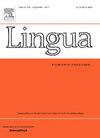新西兰手语中第二人称称呼变化的语用学研究
IF 1.3
3区 文学
0 LANGUAGE & LINGUISTICS
引用次数: 0
摘要
新西兰手语(NZSL)使用的语境和目的的扩展以及在线视频通信模式的支持导致了尚未描述的新类型特征的出现。着眼于当代新西兰语的在线信息视频文本,我们采用变异语用学的视角来研究食指和全手指向形式之间第二人称称呼的变异。称呼形式在构建说话人和被说话人之间的社会关系中具有重要意义,具有指示地位、社会距离和说话人立场维度的潜力。本研究采用混合方法调查了NZSL中全手代词变体的使用和社会索引性,包括分析其在在线视频文本数据集中的分布和相关因素,以及来自其他类型和时间段的数据。NZSL签字人对使用全手指向地址的语境和社会动机的元语用洞察丰富了我们对视频数据中观察到的解释。除了确认全手称呼是一种现代用法外,参与者还确定了与这种称呼的其他四种联系:类型、模式、礼貌和Māori语境。我们得出的结论是,在这些信息丰富的在线视频中,全手演讲的典型使用是一种从面对面的公共演讲环境中重新中介的特征,现在与这种公共演讲类型的在线模式相关联并复制。本文章由计算机程序翻译,如有差异,请以英文原文为准。
Pragmatics of second person address variation in New Zealand Sign Language
Expansion of contexts and purposes for the use of New Zealand Sign Language (NZSL) and the affordances of online video communication modes have led to the emergence of new genre features which have not yet been described. Focusing on contemporary online informative videotexts in NZSL, we take a variationist pragmatics lens to examining variation in second person address between index-finger and whole-hand pointing forms. Forms of address are significant in the construction of social relations between speakers and addressees, having the potential to index dimensions of status, social distance and speaker stance. This study used mixed methods to investigate the use and social indexicality of a whole-hand pronominal variant in NZSL, including analysis of its distribution and associated factors in a dataset of online videotexts and data from other genres and time periods. Metapragmatic insight of NZSL signers about contextual and social motivations for the use of whole-hand pointing address enriches our interpretation of observations in the video data. In addition to confirming that the whole-hand form of address is a modern usage, participants identified four other associations with this form: genre, mode, politeness, and Māori context. We conclude that the typical use of whole-hand address in these informative online videos is a feature re-mediated from in-person public speaking contexts, which is now associated with and replicated in the online modality of this public address genre.
求助全文
通过发布文献求助,成功后即可免费获取论文全文。
去求助
来源期刊

Lingua
Multiple-
CiteScore
2.50
自引率
9.10%
发文量
93
审稿时长
24 weeks
期刊介绍:
Lingua publishes papers of any length, if justified, as well as review articles surveying developments in the various fields of linguistics, and occasional discussions. A considerable number of pages in each issue are devoted to critical book reviews. Lingua also publishes Lingua Franca articles consisting of provocative exchanges expressing strong opinions on central topics in linguistics; The Decade In articles which are educational articles offering the nonspecialist linguist an overview of a given area of study; and Taking up the Gauntlet special issues composed of a set number of papers examining one set of data and exploring whose theory offers the most insight with a minimal set of assumptions and a maximum of arguments.
 求助内容:
求助内容: 应助结果提醒方式:
应助结果提醒方式:


